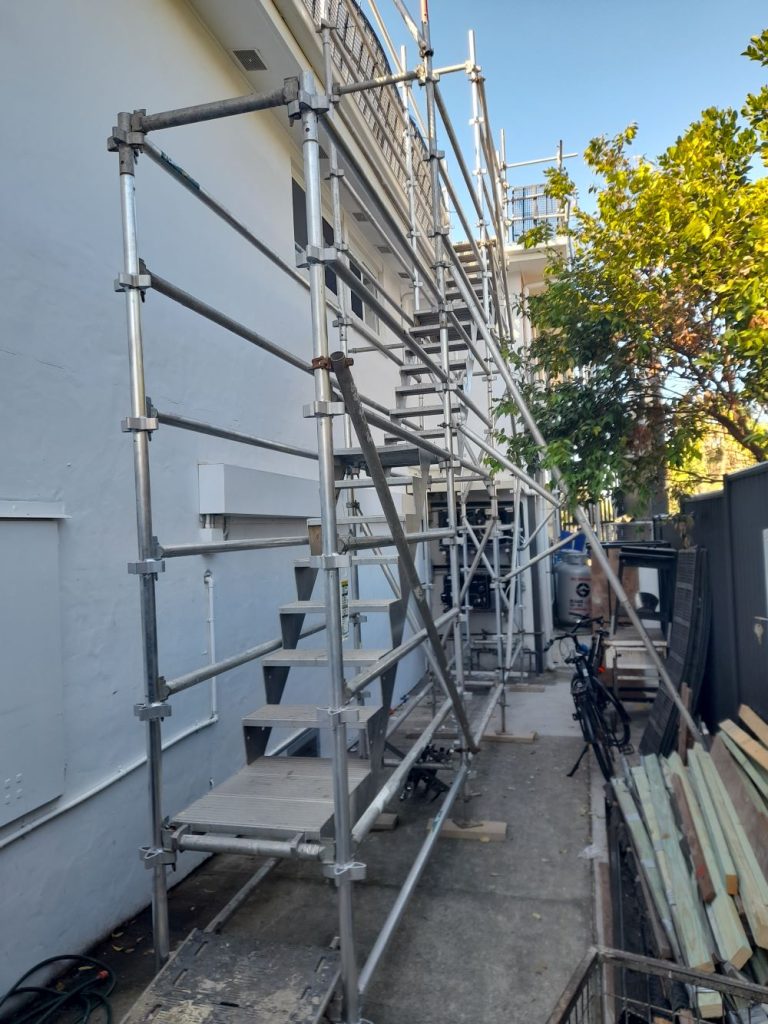If you have ever been involved with or around scaffolding, you might have contemplated the practicality and safety of positioning a ladder atop it to reach elevated areas. Although this may initially appear to be a straightforward and convenient solution, there are numerous critical safety factors that warrant careful consideration before proceeding. Gaining a comprehensive understanding of the risks and regulations associated with this practice is vital for ensuring not only your safety but also the safety of others present in the workspace.
Despite its seemingly simple nature, using a ladder atop scaffolding is EXCEEDINGLY hazardous. Introducing ANY extraneous elements to a stable scaffolding framework can generate significant dangers. The potential risks associated with this practice are considerable and should never be overlooked or underestimated. Prioritising safety over convenience in any construction environment is essential for preventing accidents and maintaining a secure working space.
This article will delve into the numerous reasons why positioning a ladder on scaffolding is ill-advised, emphasising the potential hazards while also discussing safer alternatives that should be taken into consideration instead.

Assessing the Safety Risks Associated with Ladder Use on Scaffolding
The unequivocal answer is NO; employing a ladder on scaffolding is NOT safe.
Utilising a ladder on scaffolding introduces significant dangers that could jeopardise the safety of the entire structure. The primary purpose of scaffolding is to provide a secure and stable working platform that adheres to stringent load-bearing requirements. When a ladder or any additional equipment is placed on this structure, it can compromise the stability of the entire system, heightening the risk of accidents, falls, and severe injuries. Thus, while it may seem like a clever shortcut to access higher regions, the potential hazards far outweigh any perceived benefits.
Also Read: What NOT to Do When Using Scaffolding for Safety
Recognising the Specific Dangers of Using a Ladder on Scaffolding
Having established that the use of a ladder on scaffolding is fraught with danger, let’s closely examine the specific hazards associated with this practice:
1. Instability of the Scaffolding Structure
Scaffolding is meticulously engineered to act as a safe and robust working platform; however, the introduction of a ladder can severely disrupt this balance. Ladders are specifically designed to rest on solid ground rather than atop another structure. When positioned on scaffolding, a ladder can destabilise the entire setup, significantly increasing the risk of falls, slips, or even catastrophic scaffold failure. This precarious situation poses serious hazards not only to the individual using the ladder but also to everyone in the surrounding area.
2. Increased Fall Risk Due to Height Elevation
When you are working on scaffolding, you are already elevated above the ground. Adding a ladder to the mix can further exacerbate this elevation, consequently amplifying the risk of falling. The precarious nature of using a ladder on scaffolding can lead to dangerous scenarios, particularly if the ladder shifts, slips, or fails to maintain its stability. The potential for severe injuries escalates dramatically with increased height, making this practice exceedingly risky and inadvisable.
Also Read: Who Is Responsible for Scaffold Hire and Safety?
3. Improper Ladder Angle Heightens Accident Risk
Ladders are designed to be utilised at specific angles to ensure optimal safety during operation. Placing a ladder haphazardly atop scaffolding prevents the attainment of the correct angle necessary for stability. An improperly positioned ladder is susceptible to slipping or sliding, especially when placed on a surface that lacks the necessary solidity and support. Furthermore, scaffolding does not provide the same level of stability as a solid ground surface, making it challenging to secure the ladder at the appropriate angle, thereby significantly increasing the risk of accidents.
4. Insecure Attachment Creates Major Hazards
Using a ladder on scaffolding often results in insufficient securing of the ladder itself. Most scaffolding setups are not designed to accommodate ladders, which means there is generally no reliable method to attach them securely. Although the ladder may appear stable initially, any movement, vibrations, or slips can swiftly lead to the ladder falling or tipping over, posing a significant risk to users and those nearby.
5. Violation of OSHA Safety Regulations
If you are working on a construction site, compliance with safety regulations is frequently mandated. The Occupational Safety and Health Administration (OSHA) enforces rigorous guidelines regarding the safe use of scaffolding and ladders. Improper utilisation of a ladder on scaffolding can result in violations of OSHA standards (such as 1926.1053 for ladders and 1926.451 for scaffolds). Non-compliance can lead to legal consequences, fines, penalties, or even project shutdowns, underscoring the importance of diligently adhering to safety guidelines.
6. Risks of Certification Nullification
Every scaffolding installation undergoes a comprehensive certification process to ensure that professionals deem it safe for use. Altering that setup by adding a ladder compromises its certification status. In the event of an incident, you may discover that you lack coverage under work health and safety regulations. Without valid certification, you assume considerable risk, which is an unacceptable gamble with potentially dire consequences.
Exploring Safer Alternatives for Accessing Elevated Areas
Now that we have thoroughly explored the reasons against using a ladder on scaffolding, let’s investigate safer alternatives for achieving your desired height without compromising safety or violating regulations:
Make Use of Built-In Scaffold Access Solutions for Enhanced Safety
Most scaffolding installations come equipped with integrated access features, such as ladders or stairways. These access points are specifically designed to ensure safety while navigating up and down the scaffolding. If your scaffolding includes these built-in access options, it is crucial to make full use of them! They are engineered to work harmoniously with the scaffolding system, significantly enhancing overall security and minimising the likelihood of accidents.

Consider Work Platforms or Extensions for Safer Access to Heights
Another viable alternative is to utilise a work platform or an extension. These solutions are specifically designed to provide a stable surface for working while offering safe access to elevated areas. They represent a far more secure option than attempting to balance a ladder on scaffolding. Work platforms are robust and certified for use with scaffolding, ensuring your safety while facilitating the efficient and effective completion of tasks at elevated heights.
Final Insights on the Dangers of Ladder Use with Scaffolding
So, can you safely position a ladder on scaffolding?
The definitive answer remains no! Utilising a ladder on scaffolding can lead to structural instability, heightened fall risk, and violations of essential safety regulations. The potential consequences simply do not justify the associated risks. Instead, take advantage of built-in scaffold access methods or opt for safer alternatives, such as work platforms. Always prioritise safety; the last thing you want is to jeopardise your well-being or that of others for the sake of convenience. By adhering to proper guidelines, you will ensure that you remain safe and compliant while on the job.
The Article: Ladder Safety on Scaffolding: What You Need to Know first appeared on https://writebuff.com
The Article Ladder Safety Tips for Scaffolding You Must Know Was Found On https://limitsofstrategy.com

